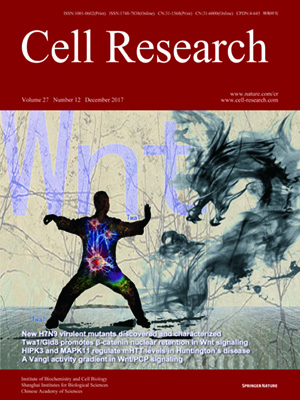Volume 27 Issue 12, December 2017: 1409-1421 | Open Access
ORIGINAL ARTICLES
H7N9 virulent mutants detected in chickens in China pose an increased threat to humans
Jianzhong Shi1,*, Guohua Deng1,*, Huihui Kong1,*, Chunyang Gu1,*, Shujie Ma1,*, Xin Yin1,*, Xianying Zeng1, Pengfei Cui1, Yan Chen1, Huanliang Yang1, Xiaopeng Wan1, Xiurong Wang1, Liling Liu1, Pucheng Chen1, Yongping Jiang1, Jinxiong Liu1, Yuntao Guan1, Yasuo Suzuki2, Mei Li1, Zhiyuan Qu1, Lizheng Guan1, Jinkai Zang1, Wenli Gu1, Shuyu Han1, Yangming Song1, Yuzhen Hu1, Zeng Wang1, Linlin Gu1, Wenyu Yang1, Libin Liang1, Hongmei Bao1, Guobin Tian1, Yanbing Li1, Chuanling Qiao1, Li Jiang1, Chengjun Li1, Zhigao Bu1 and Hualan Chen1
1State Key Laboratory of Veterinary Biotechnology, Harbin Veterinary Research Institute, Chinese Academy of Agricultural Sciences, Harbin 150001, China;
2College of Life and Health Sciences, Chubu University, Aichi 487-8501, Japan
Correspondence: Hualan Chen,(chenhualan@caas.cn)
Certain low pathogenic avian influenza viruses can mutate to highly pathogenic viruses when they circulate in domestic poultry, at which point they can cause devastating poultry diseases and severe economic damage. The H7N9 influenza viruses that emerged in 2013 in China had caused severe human infections and deaths. However, these viruses were nonlethal in poultry. It is unknown whether the H7N9 viruses can acquire additional mutations during their circulation in nature and become lethal to poultry and more dangerous for humans. Here, we evaluated the evolution of H7N9 viruses isolated from avian species between 2013 and 2017 in China and found 23 different genotypes, 7 of which were detected only in ducks and were genetically distinct from the other 16 genotypes that evolved from the 2013 H7N9 viruses. Importantly, some H7N9 viruses obtained an insertion of four amino acids in their hemagglutinin (HA) cleavage site and were lethal in chickens. The index strain was not lethal in mice or ferrets, but readily obtained the 627K or 701N mutation in its PB2 segment upon replication in ferrets, causing it to become highly lethal in mice and ferrets and to be transmitted efficiently in ferrets by respiratory droplet. H7N9 viruses bearing the HA insertion and PB2 627K mutation have been detected in humans in China. Our study indicates that the new H7N9 mutants are lethal to chickens and pose an increased threat to human health, and thus highlights the need to control and eradicate the H7N9 viruses to prevent a possible pandemic.
10.1038/cr.2017.129
FULL TEXT | PDF
Browse 1569


